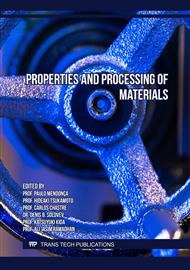[1]
E.S. Gorkunov, A.I. Ul'yanov, Magnetic methods and devices for quality control of powder metallurgy products, Ekaterinburg: UrO RAN, 1996, p.205
Google Scholar
[2]
M.N. Miheev, E.S. Gorkunov, Magnetic methods of structural analysis and non-destructive testing, M.: Nauka, 1993, p.252.
Google Scholar
[3]
V.E. Shcherbinin, E.S. Gorkunov, Magnetic control of metals quality, Ekaterinburg: UrO RAN, 1996, p.264.
Google Scholar
[4]
G.V. Bida, E.S. Gorkunov, V.M. Shevnin, Magnetic control of the mechanical properties of rolled products, Ekaterinburg: UrO RAN, 2002, p.253.
Google Scholar
[5]
I. Petryshynets, F. Kovac, V. Stoyka, etc., Influence of microstructure evolution on the coercive forces in low silicon non-oriented steels, Acta Phys. Polonica A, 118 No. 5 (2010) 1013-1014.
DOI: 10.12693/aphyspola.118.1013
Google Scholar
[6]
A.M. Ivanov, S.S. Vashenko, Changes of coercive force of steel samples with various ductility reached by thermomechanical processing at stretching, Rev. Adv. Mater. Sci. 25 (2010) 269-272.
Google Scholar
[7]
Yu Zhang, Zijian Wang, Yilin Wang, etc, A study on the relationship between hardness and magnetic properties of ultra-high strength steel, Adv. Mater. Res. 1063 (2014) 78-81.
DOI: 10.4028/www.scientific.net/amr.1063.78
Google Scholar
[8]
O.V. Balina, Effects of low-cycle loading on the structure and properties of low-alloy pipe steels, Avtoreferat diss., Tyumen': 2008, p.20.
Google Scholar
[9]
E.S. Gorkunov, Yu.V. Subachev, S.M. Zadvorkin i dr., Effects of heat treatment and elastoplastic deformation on the magnetic properties of 50N2M powder steel, Fizicheskaya mezomekhanika. 14 №2 (2011) 27-38.
Google Scholar
[10]
V.G. Kuleev, T.P. Car'kova, A.P. Nichipuruk i dr., Study of causes of significant differences in the values of the coercive force, remnant magnetization and initial magnetic permeability of ferromagnetic steels in loaded and unloaded states under their plastic tension, Fizika metallov i metallovedenie. 103 №2 (2007) 136-146.
DOI: 10.1134/s0031918x07020032
Google Scholar
[11]
E.S. Gorkunov, S.M. Zadvorkin, S.V. Smirnov i dr., Relationship of parameters of the stress-strain state and the magnetic characteristics of carbon steels, 103 №3 (2007) 322-327.
Google Scholar
[12]
A.M. Ivanov, Change in coercive force of steel samples with different ductility at tension, Zavodskaya laboratoriya. Diagnostika materialov. №1 (2009) 59-61.
Google Scholar
[13]
N.L. Zaytsev, Improving methods of assessments of a stress state of structures according to the results coercive measurements, Sol. St. Phen. 284 (2018) 1332-1336.
DOI: 10.4028/www.scientific.net/ssp.284.1332
Google Scholar
[14]
O.A. Troickij, Yu.V. Baranov, YU.S. Avraamov i dr., Physical foundations and processing technologies of modern materials: theory, technology, structure and properties, V 2-h tomah, T. 1. Moskva, Izhevsk: Institut komp'yuternyh issledovanij, 2004, p.590.
Google Scholar
[15]
S.V. Vorob'ev, Structural scale levels of high-cycle fatigue of austenitic stainless steel under pulse current, Avtoreferat dissertacii na soiskanie uchenoj stepeni kandidata tekhnicheskih nauk, Novokuzneck, 2007, p.19.
Google Scholar


